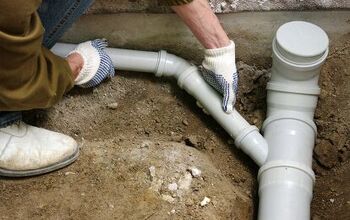Cast Iron Vs. PVC Sewer Pipe: What Are The Major Differences?

Plumbing has completely changed the way we live in our homes and has brought about an element of sanitation and convenience all in one. Plumbing systems can vary between commercial and residential applications, but usually, cast iron or PVC pipe are the materials of choice for contractors worldwide. While each pipe has its advantages, one pipe is superior to the other.
PVC sewer pipe is by far the superior material for piping because it is lightweight, durable, and affordable. Cast iron, commonly used between the 1930s and 1980s, is durable and strong but can degrade over time. While PVC will last about 100 years or more, expect to get about 80 years of life from a cast iron plumbing system.
Of course, other factors go into deciding which material is better to use for plumbing applications in your home. Cast iron is undoubtedly strong and can withstand a tremendous amount of force, making it perfect for high-pressure sewer applications.
Simply having cast-iron pipes for your sewer in your home is no need for concern. This incredibly long-lasting material can serve your home for years without replacement. As you start to notice signs of corrosion and degradation, gradually replace your cast iron pipes with PVC to upgrade the plumbing system in your home.
Do You Need to Hire a Plumber?
Get free, zero-commitment quotes from pro contractors near you.

What is Cast Iron Pipe?
Cast iron pipe is a common material that is used for various plumbing applications throughout your home. The pipe is usually made from gray cast iron and is an old technology that has been around for centuries. As early as the 1600s, cast iron has been used to move water, sewage, and gas from place to place.
Although most cast iron that is used is uncoated, later cast iron pipes have been coated with different linings to reduce the amount of corrosion. A lined cast iron pipe also helps to improve hydraulics, allowing water to move more quickly through the pipe. This prevalent building material is found throughout the world and was the go-to pipe choice for buildings until about the 1980s.
What is PVC Pipe?
PVC is one of the most popular options for commercial and residential buildings compared to other piping materials. This piping material is made from plastic and has been used in various applications for over 80 years. PVC pipe has many benefits, including its versatility and relatively light weight. Plus, PVC is incredibly durable and can withstand both corrosion and temperature expansion.
PVC pipe has several applications and can help transport water, sewage, and gas. There are many size options available with different diameters, wall thicknesses, and lengths. Not only is PVC readily available and extremely easy to work with, but it is also incredibly cost-effective, allowing construction projects to reduce costs significantly.
How Long Does Cast Iron Pipe Last?
Cast iron pipe is very long-lasting, making it a popular construction material option even in modern construction. Expect to get about 80 to 100 years out of a cast-iron plumbing system. This durable and robust pipe can withstand incredible amounts of water pressure and is thick and durable.
However, the cast iron is subject to corrosion and rust over time. While the outside of the pipe may stay in decent shape, continually running water through the line for years can cause rust and corrosion to form. As calcium and magnesium deposits are left to collect on the inside of the pipe, the overall integrity and strength will become compromised.
How Long Does PVC Pipe Last?
One of the most significant benefits of using PVC pipe is the incredibly long lifespan of this material. PVC pipe will routinely last for 100 years, and it is not uncommon to get even more life out of this fantastic material. Unlike alternative materials, PVC can withstand corrosion, even from the most acidic elements.
Plus, PVC is incredibly durable and can withstand high pressures. Thicker walled PVC pipe is often used for high-pressure systems and can still withstand years of wear and tear. PVC pipe is not subject to temperature expansion like either material and is often the material of choice, particularly in hot or cold climates.
What Can Cast Iron Be Used For?
Cast iron has several uses in both commercial and residential applications. Cast iron pipes can be used to move water, sewage, or gas from place to place. This pipe material is solid and durable, so it is commonly used for high-pressure sewer systems.
What Are Common PVC Applications?
PVC can be used just about anywhere in your home, especially anywhere that has plumbing. PVC is used for water systems, gas systems, and even as a sewer drain. This material is incredibly versatile and has several applications throughout the home. In many instances, PVC is the preferred material because it is lightweight, easy to work with, long-lasting, and strong.
How Much Does Cast Iron Pipe Cost?
Depending on the thickness of cast iron purchased, this material can cost between $12.50 and $30 per linear foot. Compared to other pipe materials, this is a relatively expensive product. The manufacturing process to create cast iron pipes is labor-intensive, which helps to drive a higher price point.
How Much Does PVC Pipe Cost?
PVC comes in different thicknesses and diameters, but the standard Schedule 30 or 40 PVC pipe commonly used for plumbing sewer systems will run about $3 per linear foot. This price point makes PVC incredibly attractive to construction workers around the world. Coupled with its relative affordability, PVC is strong and durable and is easy to work with. Creating PVC pipes from plastic is easy and efficient, which helps keep the material’s price low and affordable.
Can PVC Crack in the Cold?
One of the major concerns working with PVC pipes is the brittleness of the plastic. Like many materials, plastic can become brittle and break, especially if it is subjected to frigid temperatures below freezing. Unfortunately, PVC can break with cold temperatures.
However, the good news is that PVC still retains most of its strength, even at freezing temperatures. When the temperature drops to 32 degrees F, PVC maintains about 90% of its total strength. Most PVC pipes that are subject to exterior temperatures are buried underground, which helps to provide additional insulation and protection from the weather.
Is It a Good Idea to Replace Cast Iron Pipe with PVC?
Although PVC pipe is the better material for construction projects, there is no immediate need to replace the cast iron pipes in your home instantly. Cast iron was the long-held standard for plumbing material, and there is a good reason it was used so often. This material is long-lasting and strong and will hold up for many years, sometimes over 100 years, with ongoing maintenance and care. If you have cast-iron pipes in your home that are in good shape, there is no need to replace the pipes.
However, if your cast iron is starting to show signs of age, it may be a good idea to begin to transition to PVC piping with regular leaks and breaks. As parts of your plumbing system degrade, gradually move toward the alternative piping material. In the long run, you’ll be able to create a better plumbing system and increase the overall value of your home with the modern plumbing upgrade.
Why Is Cast Iron Plumbing Bad?
Although this material was once in high demand, and it is a largely durable and robust material, cast iron pipes can fail over time. These pipes tend to rust, which slowly allows water to leak through the pipes. Plus, cast iron is particularly susceptible to tree root damage. Trees seeking a water source will regularly wrap their roots around the pipes, slowly crushing the pipe until it bursts.
Plus, pipe iron has some other traits that can make it undesirable compared to other modern construction materials used today. Contractors consider cast iron plumbing bad because:
- Cast iron has a low tensile strength
- Individual parts can be sensitive to cooling
- Poor impact resistance
- Difficult to manufacture
- Failures are drastic and sudden.
If you have cast-iron pipes in your home, though, there is no need to panic. Just because you have cast iron plumbing does not mean that you need to start a significant plumbing overhaul project to replace your cast iron with PVC. A better approach is to gradually replace pipe sections as problems occur and stay particularly mindful of possible warning signs for leaks.
Do You Need to Hire a Plumber?
Get free, zero-commitment quotes from pro contractors near you.

Related Questions
What time periods was cast iron pipe commonly used?
Cast iron pipe was the long-held standard for indoor plumbing because it was strong and durable. Today, most homes are built with PVC due to the relative affordability and longevity of the material. Most houses with indoor plumbing in the 1930s had cast-iron pipes. Cast iron piping was an incredibly labor-intensive job, so only wealthy homes could afford this luxury. Today, you can expect to find cast iron pipes in houses dating from the 1930s until about the 1980s, when PVC primarily took over as the construction material of choice.
Does cast iron pipe have any dangers?
When it comes to a healthy and safety standpoint, cast iron plumbing does not pose any immediate danger to your health. There is no worry that elements or minerals like lead can leach into your drinking water. The only real trouble with cast iron plumbing is the limited lifespan. This pipe can be susceptible to corrosion over time. The most significant indicator that your lines are starting to break down is discolored or rusty-looking water.

We are a team of passionate homeowners, home improvement pros, and DIY enthusiasts who enjoy sharing home improvement, housekeeping, decorating, and more with other homeowners! Whether you're looking for a step-by-step guide on fixing an appliance or the cost of installing a fence, we've here to help.
More by Upgraded Home Team



























